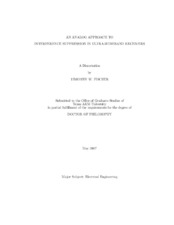| dc.description.abstract | Because of the huge bandwidth of Ultra-Wideband (UWB) systems, in-band narrowband
interference may hinder receiver performance. In this dissertation, sources
of potential narrowband interference that lie within the IEEE 802.15.3a UWB bandwidth
are presented, and a solution is proposed. To combat interference in Multi-Band
OFDM (MB-OFDM) UWB systems, an analog notch filter is designed to be included
in the UWB receive chain. The architecture of the filter is based on feed-forward
subtraction of the interference, and includes a Least Means Squared (LMS) tuning
scheme to maximize attenuation. The filter uses the Fast Fourier Transform (FFT)
result for interference detection and discrete center frequency tuning of the filter. It
was fabricated in a 0.18 µm process, and experimental results are provided. This is
the first study of potential in-band interference sources for UWB. The proposed filter
offers a practical means for ensuring reliable UWB communication in the presense of
such interference.
The Operational Transconductance Amplifier (OTA) is the predominant building
block in the design of the notch filter. In many cases, OTAs must handle input
signals with large common mode swings. A new scheme for achieving rail-to-rail
input to an OTA is introduced. Constant gm is obtained by using tunable level
shifters and a single differential pair. Feedback circuitry controls the level shifters
in a manner that fixes the common mode input of the differential pair, resulting in consistent and stable operation for rail-to-rail inputs. As the new technique avoids
using complimentary input differential pairs, this method overcomes problems such
as Common Mode Rejection Ratio (CMRR) and Gain Bandwidth (GBW) product
degradation that exist in many other designs. The circuit was fabricated in a 0.5µm
process. The resulting differential pair had a constant transconductance that varied
by only ±0.35% for rail-to-rail input common mode levels. The input common mode
range extended well past the supply levels of ±1.5V, resulting in only ±1% fluctuation
in gm for input common modes from -2V to 2V. | en |


